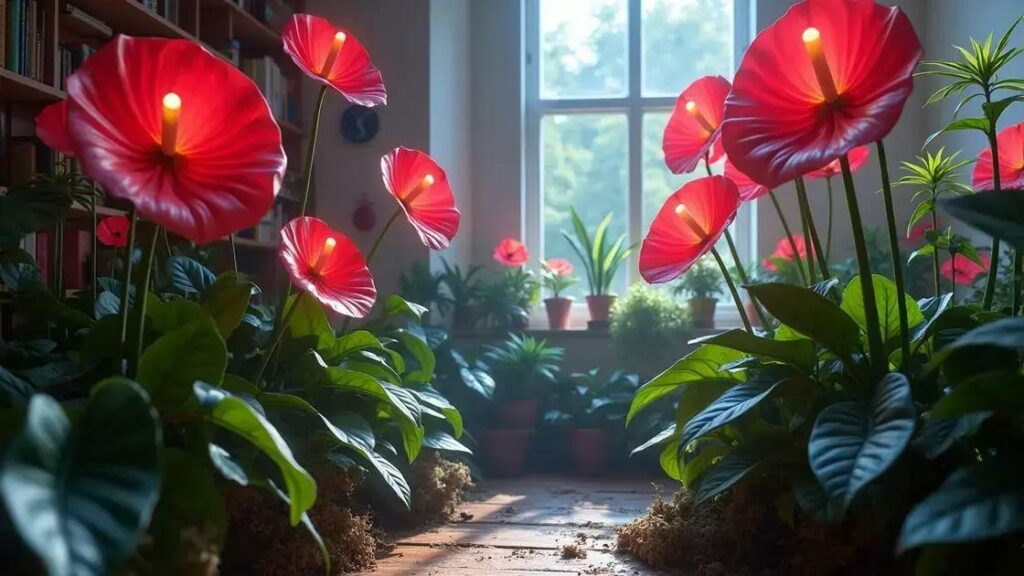How to care for anthurium plant indoors can make all the difference in creating a lush, vibrant atmosphere in your living space. These stunning plants thrive on attention, but they also have unique needs and preferences. Discover the best practices that will turn your indoor garden into a tropical haven with vibrant blooms.
Table of Contents
ToggleUnderstanding anthurium plant needs at home
Understanding anthurium plant needs at home is crucial for maintaining their stunning blooms and vibrant foliage. These tropical plants, native to Central and South America, have specific requirements that need to be met to thrive indoors. Whether you’re a seasoned plant enthusiast or just starting your indoor gardening journey, knowing how to care for anthuriums will elevate your plant care routine.
Here’s what you need to consider for the best care:
- Watering: Anthuriums prefer consistent moisture but are sensitive to overwatering. Use a watering schedule that allows the top inch of soil to dry out between waterings.
- Soil requirements: A well-draining potting mix is essential. Consider a blend of peat, bark, and perlite, which mimics their natural habitat. You can find more about suitable mixes by exploring indoor gardening techniques.
- Humidity: High humidity levels are ideal for anthuriums. Maintaining humidity levels between 60-80% can support their growth. You might use a humidifier or pebble trays to keep moisture in the air.
Maintaining the right environment at home will ensure your anthurium thrives. Here are some specific needs to address:
- **Sunlight:** Place them in bright, indirect sunlight to prevent leaf scorch.
- **Temperature:** Aim for a temperature range of 65-80°F (18-27°C) and avoid cold drafts.
- **Fertilization:** Use a balanced, water-soluble fertilizer every 4-6 weeks during the growing season to promote healthy growth and blooms.
By providing these essential elements, you’re setting your anthurium plant up for success and vibrant beauty!
Essential watering and soil requirements

Essential watering and soil requirements are vital for keeping your anthurium plant thriving indoors. Proper moisture levels and the right soil mixture can significantly impact your plant’s health and vibrant blooms. Understanding how to balance these needs will lead to a flourishing indoor garden.
The following guidelines will help you master the watering and soil care for your anthurium:
Optimal watering practices
Water is crucial for your anthurium plant’s growth, but knowing how and when to water is essential:
- Watering frequency: Generally, water your anthurium every 1-2 weeks during the growing season, depending on humidity levels and temperature.
- Signs of underwatering: Yellowing leaves or dry soil indicate your plant needs more water.
- Signs of overwatering: Signs include wilting leaves or root rot, which may require you to adjust your watering schedule.
Choosing the right soil
The soil you choose significantly affects your anthurium’s health. Here are the most important characteristics:
- Well-draining mix: Use a potting mix that allows excess water to drain easily, preventing root rot.
- Soil composition: A good blend includes peat, perlite, and orchid bark, mimicking their natural growing conditions. For specific soil mixes, consider exploring indoor gardening techniques.
- pH levels: Aim for a slightly acidic to neutral pH (5.5 to 7.0) to facilitate nutrient absorption.
By adhering to these essential watering and soil requirements, you can ensure your anthurium thrives, showcasing its beautiful blooms all year round!
Optimal sunlight exposure for indoor anthuriums
Optimal sunlight exposure for indoor anthuriums is essential for healthy growth and vibrant blooms. These tropical plants thrive in bright, indirect sunlight, and understanding how to provide the right lighting can significantly enhance their appearance and longevity.
Here are key points to consider for sunlight exposure when caring for your anthurium:
Understanding light requirements
- Bright, indirect sunlight: Anthuriums flourish when placed in locations that receive bright, filtered light. Direct sunlight can scorch their leaves, so place them near east or north-facing windows for the best results.
- Signs of insufficient light: Look for yellowing leaves or leggy growth. If your plant isn’t producing blooms, it may not be receiving enough light.
Adjusting light exposure
Here’s how to adjust and improve light conditions for your anthurium:
- **Rotate your plant:** Every few weeks, turn your anthurium to ensure even light distribution, promoting balanced growth.
- **Use sheer curtains:** If placing your plant near a south or west-facing window, use sheer curtains to diffuse the light and protect your plant from harsh rays.
- **Consider supplemental lighting:** In low-light conditions, you might use grow lights to help your anthurium thrive indoors.
By carefully managing the optimal sunlight exposure for your indoor anthuriums, you’ll create an environment that allows them to flourish beautifully. For more tips on plant care, consider exploring indoor gardening techniques.
In conclusion
Caring for your anthurium plant indoors is a rewarding experience that can add vibrant beauty to your space. By understanding their watering and soil requirements, optimal sunlight exposure, and providing the right environmental conditions, you can ensure these tropical plants thrive and display their stunning blooms. With a little attention to detail, your anthurium can become a centerpiece in your indoor garden. For additional tips on enhancing your indoor garden, continue exploring care techniques tailored to your plants’ specific needs.

